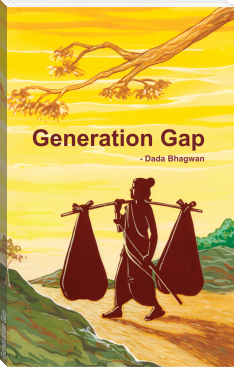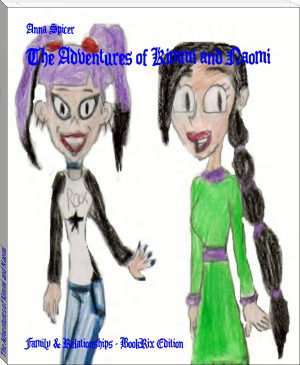Death: Before, During & After... by Dada Bhagwan (book recommendations based on other books .txt) 📖

- Author: Dada Bhagwan
Book online «Death: Before, During & After... by Dada Bhagwan (book recommendations based on other books .txt) 📖». Author Dada Bhagwan
As Expounded by Dada Bhagwan
Death Before, During, and After…
Originally Compiled in Gujarati by: Dr. Niruben Amin
Trimantra
The Three Mantras That Destroy All Obstacles in Life
Namo Vitaraagaya
I bow to the Ones who are absolutely free from all attachment and abhorrence
Namo Arihantanam
I bow to the living Ones who have annihilated all internal enemies of anger, pride, deceit and greed
Namo Siddhanam
I bow to the Ones who have attained the state of total and final liberation
Namo Aayariyanam
I bow to the Self-realized masters who impart the Knowledge of the Self to others
Namo Uvazzayanam
I bow to the Ones who have received the Knowledge of the Self and are helping others attain the same
Namo Loye Savva Sahunam
I bow to the Ones, wherever they may be, who have received the Knowledge of the Self
Eso Pancha Namukkaro
These five salutations
Savva Pavappanasano
Destroy all demerit karma
Mangalanam cha Savvesim
Of all that is auspicious
Padhamam Havai Mangalam ||1||
This is the highest
Om Namo Bhagavate Vasudevaya ||2||
I bow to the Ones who have attained the absolute Self in human form
Om Namah Shivaya ||3||
I bow to all human beings who have become instruments for the salvation of the world
Jai Sat Chit Anand
Awareness of the Eternal is Bliss
Who is Dada Bhagwan ?
In June 1958, around 6 o'clock one evening, amidst the hustle and bustle of the Surat railway station while seated on a bench, ‘Dada Bhagwan’ manifested completely within the sacred bodily form of Ambalal Muljibhai Patel. Nature revealed a remarkable phenomenon of spirituality! In the span of an hour, the vision of the universe was unveiled to him! Complete clarity for all spiritual questions such as, ‘Who are we? Who is God? Who runs the world? What is karma? What is liberation?’ etc. was attained.
What he attained that evening, he imparted to others through his original scientific experiment (Gnan Vidhi) in just two hours! This has been referred to as the Akram path. Kram means to climb up sequentially, step-by-stepwhile Akram means step-less, a shortcut, the elevator path!
He, himself, would explain to others who Dada Bhagwan is saying, “The one visible before you is not Dada Bhagwan. I am the Gnani Purush and the One who has manifested within is Dada Bhagwan who is the Lord of the fourteen worlds. He is also within you, and within everyone else too. He resides unmanifest within you, whereas here (within A. M. Patel), He has manifested completely! I, myself, am not God (Bhagwan); I also bow down to the Dada Bhagwan who has manifest within me.”
*****
The Current Link to Attain Self-Realization
After attaining the Knowledge of the Self in 1958, absolutely revered Dada Bhagwan (Dadashri) traveled nationally and internationally to impart spiritual discourse and Self-realization to spiritual seekers.
During his lifetime itself, Dadashri had given the spiritual power to Pujya Dr. Niruben Amin (Niruma) to bestow Self-realization to others. In the same way, after Dadashri left his mortal body, Pujya Niruma conducted spiritual discourses (satsang) and imparted Self-realization to spiritual seekers, as an instrumental doer. Dadashri had also given Pujya Deepakbhai Desai the spiritual power to conduct satsang. At present, with the blessings of Pujya Niruma, Pujya Deepakbhai travels nationally and internationally to impart Self-realization as an instrumental doer.
After Self-realization, thousands of spiritual seekers prevail in a state free from bondage and dwell in the experience of the Self, whilst carrying out all their worldly responsibilities.
*****
Note About This Translation
The Gnani Purush, Ambalal M. Patel, also commonly known as ‘Dadashri’ or ‘Dada’, gave spiritual discourses that were in the form of answers to questions asked by spiritual aspirants. These discourses were recorded and compiled into books by Pujya Dr. Niruben Amin in the Gujarati language.
Dadashri had said that it would be impossible to translate His satsangs and the Knowledge about the Science of Self-realization word for word into other languages, because some of the meaning would be lost in the process. Therefore, in order to understand precisely the Akram Science of Self-realization, He stressed the importance of learning Gujarati.
However, Dadashri did grant His blessings to translate His words into other languages so that spiritual seekers could benefit to a certain degree and later progress through their own efforts. This book is not a literal translation, but great care has been taken to preserve the essence of His original message.
Spiritual discourses have been and continue to be translated from Gujarati. For certain Gujarati words, several translated words or even sentences are needed to convey the meaning, hence many Gujarati words have been retained within the translated text for better understanding. Where the Gujarati word is used for the first time, it is italicized, followed by a translation explaining its meaning in parenthesis. Subsequently, only the Gujarati word is used in the text that follows. This serves a two-fold benefit; firstly, ease of translation and reading, and secondly, make the reader more familiar with the Gujarati words, which is critical for a deeper understanding of this spiritual Science. The content in square brackets provides further clarity regarding the matter, which is not present in the original Gujarati content.
This is a humble attempt to present to the world, the essence of His Knowledge. While reading this translation, if there is any contradiction or discrepancy, then it is the mistake of the translators and the understanding of the matter should be clarified with the living Gnani to avoid misinterpretation.
*****
Special Note to the Reader
The Self is the Soul (Atma) within all living beings.
The term pure Soul is used by the Gnani Purush for the awakened Self, after the Gnan Vidhi. The word Self, with an uppercase ‘S’, refers to the awakened Self which is separate from the worldly-interacting self, which is written with a lowercase ‘s’.
Wherever Dadashri uses the term ‘we’, ‘us’, or ‘our’, He is referring to Himself, the Gnani Purush.
Similarly, the use of You or Your in the middle of a sentence, with an uppercase first letter, or ‘You’, ‘Your’ in single quotes at the beginning of the sentence, refers to the state of the awakened Self or Pragnya. This is an important distinction for the correct understanding of the difference between the awakened Self and the worldly-interacting self.
Wherever the name ‘Chandubhai’ is used, the reader should substitute his or her name and read the matter accordingly.
The masculine third person pronoun ‘he’ and likewise the object pronoun ‘him’ have been used for the most part throughout the translation. Needless to say, ‘he’ includes ‘she’ and ‘him’ includes ‘her’.
For reference, a glossary of all the Gujarati words is either provided at the back of this book or available on our website at:
http://www.dadabhagwan.org/books-media/glossary/
Editorial
Death induces so much fear in people, it causes them so much grief, and engulfs them in nothing but misery. And everyone has to witness death at some point in his or her life. At that time, hundreds of questions pertaining to death arise such as what are the true facts about death? However, as one does not find any answers, he gets stuck there. Everyone is undoubtedly eager to find out about the mysteries surrounding death. And a lot has been spoken about and written on the topic; one gets to know a lot about it through old wives’ tales. However, these are all flights of the imagination arising from the intellect.
What is death? What happens before death? What happens at the time of death? What happens after death? Who can talk about the experiences pertaining to death? Those who are deceased cannot speak of their experiences. Those who take birth do not have knowledge of their prior state of existence. Thus, no one knows what happens before birth and after death. That is why the mystery of which states one has to pass through before, during, and after death remains unsolved. Dadashri, upon Seeing all this in the Knowledge that has manifested within Him, has revealed all the mysteries of death exactly as they are. This has been compiled here.
Simply upon learning the facts surrounding death, the fear of death departs!
What should we do when a loved one is dying? What is our real duty? How can we improve their next life? What should we do after the death of a loved one? With what understanding can we remain stable and balanced?
And what is the truth behind the socially prescribed traditions, such as shraaddh (Hindu ceremony that pays homage to one’s ancestors), saravani (Hindu ceremony of giving bedding, cot, and so on to a Brahmin on the thirteenth day after a person’s death), brahmabhojan (holding a feast for Brahmins), giving to charity, [reading of] the Garuda Purana (one of the 18 ancient texts of Hinduism), and various other traditions? Do these rituals benefit the deceased person? Should one follow such traditions or not? What is the state and life-form of the person after death? This book clarifies these questions and more.
When the mysteries of death, which induce fear in people, are exposed, one definitely finds consolation when facing such a situation in his life.
A Gnani Purush is the One who remains separate from the body and every temporary state related to the body; He remains separate from birth and death. ‘He’ constantly remains the Knower and Seer of these, and prevails in the state of experience as the Self, the One who is never born (ajanma) and never dies (amar)! The reality of the state of the Self, the One who is never born and never dies, during the time before life, after life, and in the end moments of life, has been candidly revealed by the Gnani Purush through the perspective of Gnan (Knowledge of the Self).
The Self is indeed always beyond birth and death; It is actually in the form as absolute Knowledge (keval Gnan Swaroop). The Self is the Knower-Seer only. The Self definitely does not undergo birth or death! Despite this, through the intellect, people undergo the experience of the cycle of birth and death. So naturally, the main question arises: how do birth and death occur? At that time, what other things besides the Self are present? What happens





Comments (0)